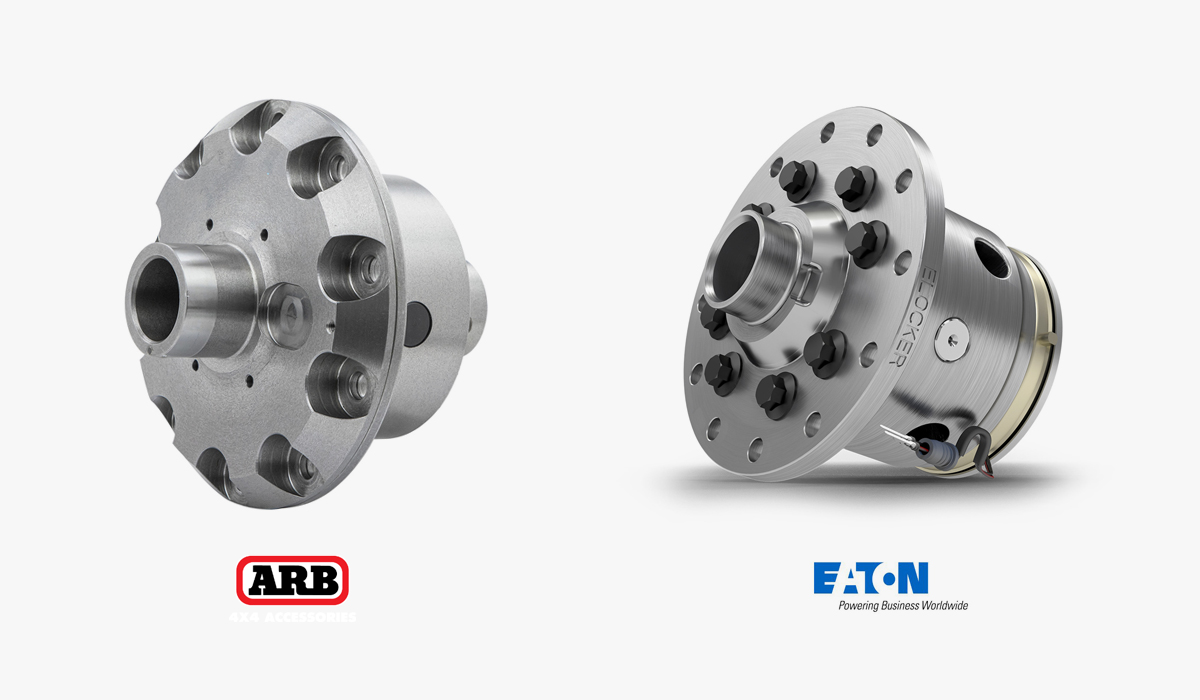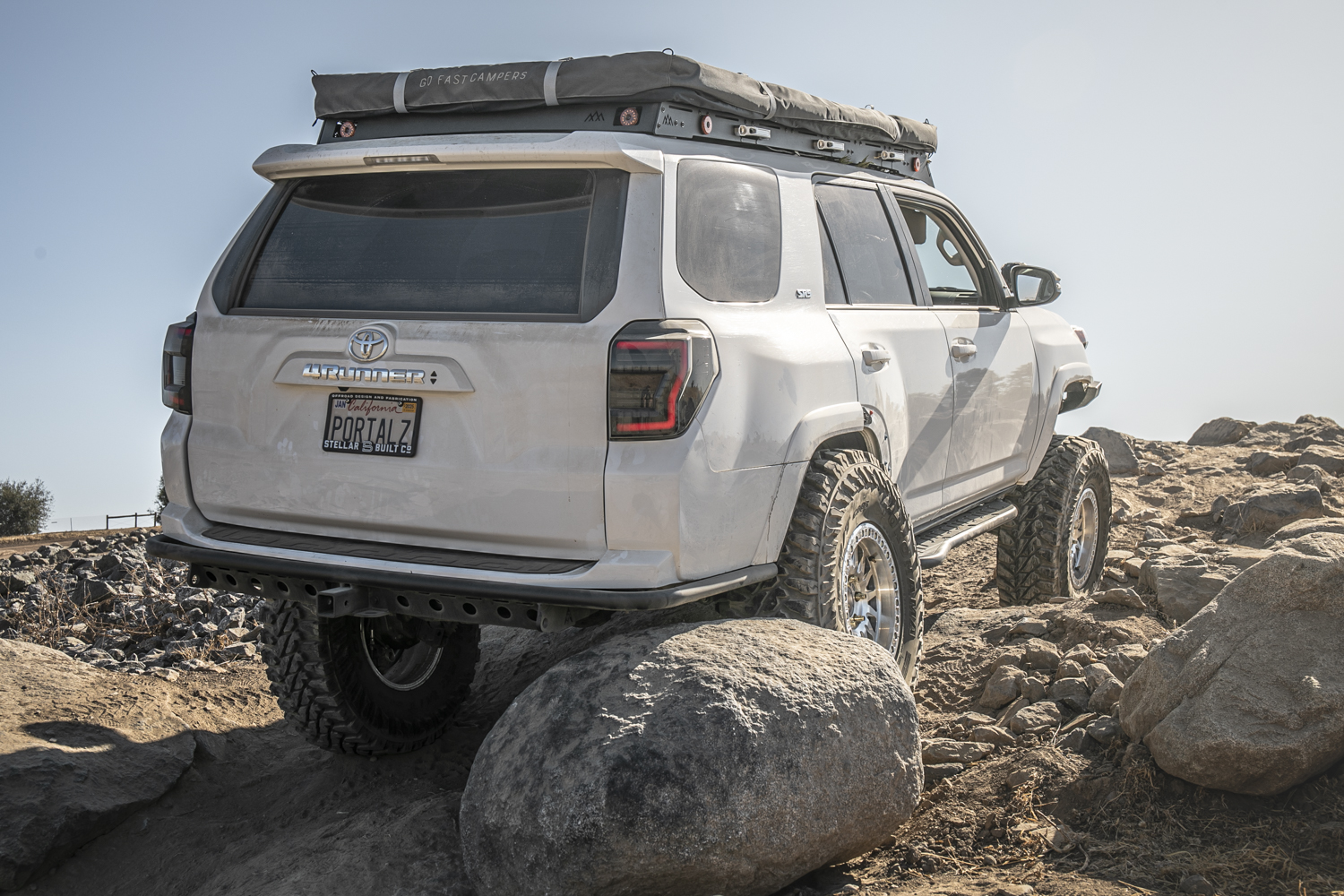
If you’re an SR5 owner like myself, you didn’t get a fancy e-locker like the TRD Off-Road and Pro guys. So the choice for locking both differentials comes down to an e-locker or an air-locker. For the sake of keeping this post simple, let’s focus on the two most popular selectable options; Eaton and ARB.
Both the Eaton and the ARB are popular choices for aftermarket locking differentials, each with its strengths and weaknesses. While both the ARB and Eaton feature a two-piece case and use forged internal spider/side gears, their activation mechanisms are very different.
The Eaton uses 12V power from your battery to activate an electromagnetic locking mechanism that locks the differential. When activated, power is supplied to the electromagnet, which applies pressure to pins that collapse a spring, turning the side gears and locking the axle shafts to spin at the same speed.
The ARB is air-actuated, with compressed air being plumbed into a sealed housing around the differential carrier. This airflow presses on a bonded piston seal, which in turn applies pressure to a clutch gear that engages the spider gears, causing both axle shafts to turn at the same speed.
Let’s look at the pros and cons in a bit more detail.
We got our ARB locker and compressor from Mudify. Mudify is a trusted retailer of ARB products, and we’ve had great experiences with them.
Find Them Online:
- ARB Air-Locker: Check Price
- On Board Air Compressor: Check Price
- Eaton E-Locker: Check Price
Table Of Contents
Pros & Cons Summary
The video above is a killer overview of all lockers; open diffs, LSDs, spooled diffs, Torsen, and of course selectable ones like the ARB and Eaton. If you’re unfamiliar with differential lockers in general, watch the video above.
So which selectable option is better? Air or electronic?
One is not technically better than the other because they both have their own unique pros and cons. And, it really depends on who you ask. If you posted this question in a Facebook group or on Instagram, you would get many different responses. But let’s quickly break down the facts
- The good: Air lockers like the ARB are typically stronger and engage fast while e-lockers like the Eaton are easier to install and the parts involved are less complicated.
- The bad: Air lockers are prone to having air leaks in the lines, seals, and/or fittings (if installed incorrectly) and e-lockers (like the Harrop/Eaton) take longer to engage and have been known to fail under extreme loads.
- The ugly: The biggest downside to air is that the system requires more working parts like an onboard air compressor, a solenoid, and a manifold which require many fittings making it hard to track down air leaks. The biggest downside to electronic is that some models unlock temporarily while changing direction (forward to reverse or reverse to forward) which can be an issue if you’re pinched and don’t have momentum/movement to re-engage.
The takeaway: Air engages quickly and offers greater strength but can be prone to air leaks and require a complex air system depending on your experience. E-lockers offer an easier install, however, they’re slower to engage, have engagement issues between forward/reverse, and may be less reliable under extreme loads. Both systems offer something unique, and choosing between them typically depends on your specific off-roading goals, and mechanical/installation knowledge.
Eaton E-Locker
The e-locker offers the convenience of electronics, engaging and disengaging with an electromagnetic locking mechanism rather than a pneumatic system. This simplifies installation and reduces potential failure points by eliminating the need for a compressor and air lines. However, it can have slightly slower engagement times and has a notable drawback: it unlocks when changing direction, unlike air or automatic systems that maintain engagement regardless of directional shifts.
With that said, most of the OEM lockers in the Toyota 4Runners, Tacomas, and Tundras are manufactured by Eaton and I have never had a problem with engagement. Over 10 years and eight different Toyotas with the OEM option, I’ve never had a single issue – no problems with directional shift engagement or slow engagement times.
So, are the cons that bad on an Eaton? I don’t think so.
ARB Air Locker
The ARB is known for its strength and quick engagement, making it ideal for serious off-road use. However, the air system adds complexity, needing an onboard compressor and air lines, which can lead to potential leaks and maintenance issues, as well as taking up space in the engine bay. Proper installation and potential upkeep can help mitigate these problems, but troubleshooting air leaks can be a serious pain—ask me how I know. I’m currently dealing with one. I have a rear ARB that a professional installed in the differential, but I installed the compressor, solenoid, manifold, and all the lines myself. Right now, there’s a leak somewhere in my setup; the compressor still kicks on when the manifold senses a pressure drop, so the locker still works when the compressor is on, but I need to find and fix that leak.
Regardless of all that, air systems are the stronger of the two and are known to be the go-to among many guys wheeling with bigger tires who depend on the strongest setup.
Final Thoughts

I’m currently running an ARB in the rear, and while there’s a leak somewhere in the setup, the locker still engages when needed because the compressor keeps the lines pressurized. It’s not a huge issue while wheeling, but it would be nice to fix the leak. My front diff is still open, and I plan on installing an Eaton for a few reasons, mainly for the convenience of installation and a lack of available switches on my Switch-Pros. All my lights, compressor, and ARB switches are already wired, and I didn’t want to mess with that setup behind my head unit. Also, my compressor/manifold is behind the grille on an R4T bracket so it’s a process to modify. It’s easier at this point to run a single 12v harness to an OEM-style switch in the cabin.
Both the options have their advantages, and I’d be happy with either in any diff but if I had to choose locations for both, I would rather have an e-locker in the front and an air locker in the rear. Since the ARB is stronger and maintains engagement regardless of directional shifts, I feel it’s better suited for the rear axle, where the demand for consistent engagement is highest. And since the e-locker momentarily disengages between directional shifts, I feel it’s better suited for the front where the need for one is less common. But they would both work well in both diffs at the end of the day.
If I had a SAS build on 42s and was plowing snow forward and reverse constantly, I’d choose the ARB for its strength, and constant engagement all day both front and rear.
If you need a strong locker and plan to frequently shift between drive and reverse, the ARB is the clear winner. However, Eaton beats ARB in installation ease and doesn’t require an air source.
For most late-model IFS trucks, I think either an e-locker or an ARB air locker with 35″ – 37″ tires and moderate wheeling would work just fine. It really just comes down to personal preference and how you want your truck set up.
What do you guys think? Air or Electronic? What would you choose and why?

Does OX make a locker for the 4Runner? I need another knob in my cabin!
Informative write up. The Toyota Elocker is made by Toyota I’d guess. So bone yard and rebuild is an option ?
I think Eaton makes the factory e-locker for them. But don’t quote me…
It could also be made by Aisin, they make the actuator for the OEM locker.